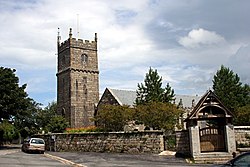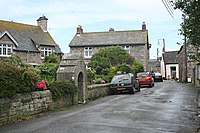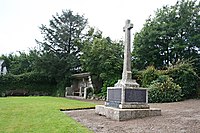Madron: Difference between revisions
Created page with "{{Infobox town |name=Madron |county=Cornwall |picture=Madron Church - geograph.org.uk - 499435.jpg |picture caption=Madron Parish Church |os grid ref=SW455314 |latitude=50.1..." |
|||
| Line 44: | Line 44: | ||
Joseph Hall, Bishop of Exeter, a noted writer and controvensialist in the days of Charles I, wrote: | Joseph Hall, Bishop of Exeter, a noted writer and controvensialist in the days of Charles I, wrote: | ||
<blockquote>"Of which kind was that noe less then miraculous cure, which at S. Maddarn's Well in CornwaIl was wrought upon a poore criple; whereof, besides the attestation of many hundreds of the neighbours, I tooke a strict impartial examination in my last triennial Visitation there. This man for sixteen years was forced to walke upon his hands, by reason of the sinews of his leggs were soe contracted that he cold not goe or walk on his feet, who upon monition in a dreame, to wash in that well, which accordingly he did, was suddainly restored to the use of his limbs, and I saw him both able to walk and gett his own maintenance. I found here was neither art or collusion, the cure done, the author our invisible God, &c."<ref>Hall, Joseph: ''The Great Mystery of Godliness'': 'of what good offices angels do God's servants' (p. 169) </ref><ref name=wp/> | <blockquote>"Of which kind was that noe less then miraculous cure, which at S. Maddarn's Well in CornwaIl was wrought upon a poore criple; whereof, besides the attestation of many hundreds of the neighbours, I tooke a strict impartial examination in my last triennial Visitation there. This man for sixteen years was forced to walke upon his hands, by reason of the sinews of his leggs were soe contracted that he cold not goe or walk on his feet, who upon monition in a dreame, to wash in that well, which accordingly he did, was suddainly restored to the use of his limbs, and I saw him both able to walk and gett his own maintenance. I found here was neither art or collusion, the cure done, the author our invisible God, &c."<ref>Hall, Joseph: ''The Great Mystery of Godliness'': 'of what good offices angels do God's servants' (p. 169) </ref><ref name=wp/></blockquote> | ||
Madron Well was, until the 18th century, the principal source of water for the nearby town of Penzance and Madron Church was the mother church of Penzance. | Madron Well was, until the 18th century, the principal source of water for the nearby town of Penzance and Madron Church was the mother church of Penzance. | ||
Latest revision as of 21:05, 12 September 2016
| Madron | |
| Cornwall | |
|---|---|
 Madron Parish Church | |
| Location | |
| Grid reference: | SW455314 |
| Location: | 50°7’59"N, 5°33’54"W |
| Data | |
| Population: | 1,591 (2011) |
| Post town: | Penzance |
| Postcode: | TR18 |
| Local Government | |
| Council: | Cornwall |
| Parliamentary constituency: |
St Ives |
Madron is a village in western Cornwall, on the Penwith peninsula, just north-west of Penzance.
Madron village is centred on an elevated site approximately two miles northwest of Penzance town centre, and the parish of the name spreads over a wider area. The parish's main villages and hamets are Tredinnick, Lower Ninnes, New Mill, Newbridge and Tregavarah. The population was 1,591 at the 2011 census.
The parish church, is in the churchtown and is dedicated to Madron (or Madrona) (in local dialect "Maddern"). The word Modron appears in Cornish and Welsh literature, Modron being the mother goddess, mother of Mabon (after whom the parish and village of St Mabyn is named).
History
Evidence of early mediæval habitation at Madron is in the form of one or two inscribed stones. One was found in the wall of the village church and has since been removed; the inscription consists of a cross and legible text, but its meaning is not clear. The other inscription was reported by R. A. Stewart Macalister in 1949 as being 'built into the N. wall of the N. aisle, west of the entrance door' of the church, but has not been seen since; Elisabeth Okasha speculates that Macalister may have seen the inscription in another church, and misremembered its location.[1] Langdon (1896) records eight stone crosses in the parish, of which one is in the churchyard and one is at Heamoor.

Madron is recorded in the Domesday Book, within the Manor of Alverton, an area that in the Anglo-Saxon period and the Middle Ages formed much of what is now the south-western part of Penwith Hundred. The church itself was once under the control of the Knights Hospitallers of Jerusalem[2] and was known by the Cornish name of Landithy, a name which is still used in parts of the village today.
Penzance Workhouse
Once within the parish was the Penzance Union Workhouse. The Penzance Poor Law Union was formed on 10 June 1837 and the population that fell within the Union at the time of the 1831 census was just under 40,000. The Penzance Union workhouse was built in 1838. Designed by George Gilbert Scott and William Bonython Moffatt, it was intended to house four hundred paupers and cost £6,050 to build. It was in use until 1948 when the National Health Service came into being and seized its endowment.[3]

About the village
The village has a Garden of Remembrance for the dead of both World Wars.
Landithy Hall, which opened in 1909, contains the Community Rooms and tea rooms where guests can stay the night and hosts many village events. It is here that Madron Parish Council holds the majority of its meetings, the other venue being Trythall School, near New Mill, as well as at St. Maddern's Primary School, below the church in Madron.
Playing field
The village has a King George V Playing Field, which serves as the home ground of Madron Football Club. Previously it has been home to both Madron Cricket Club and the Penzance & Newlyn Rugby Club 2nd XV.
Madron Well
Madron Well near the village was until the 18th-century it was the only source of water for Madron and Penzance.
Joseph Hall, Bishop of Exeter, a noted writer and controvensialist in the days of Charles I, wrote:
"Of which kind was that noe less then miraculous cure, which at S. Maddarn's Well in CornwaIl was wrought upon a poore criple; whereof, besides the attestation of many hundreds of the neighbours, I tooke a strict impartial examination in my last triennial Visitation there. This man for sixteen years was forced to walke upon his hands, by reason of the sinews of his leggs were soe contracted that he cold not goe or walk on his feet, who upon monition in a dreame, to wash in that well, which accordingly he did, was suddainly restored to the use of his limbs, and I saw him both able to walk and gett his own maintenance. I found here was neither art or collusion, the cure done, the author our invisible God, &c."[4][2]
Madron Well was, until the 18th century, the principal source of water for the nearby town of Penzance and Madron Church was the mother church of Penzance.
The well was long the focus of a May Day tradition, which was still being observed until possibly the 1870s, was for many of the youth of the village (mainly girls) to head from Penzance before sunrise, to perform a ceremony, to learn the number of years they have to wait before they get married. Two grass stems or straw, each about an inch long were fastened together with a pin and dropped into the water. Any rising bubbles denote the number of years before they get married. The ceremony was no longer held on May Day, but on a Sunday, because the girls work during the week.[5] According to The Cornishman newspaper this tradition was no longer carried out in 1879.[5]
In modern times the well has attached neo-pagans' attention, as a 'Celtic' site, and many come and tie rags to the bushes, said to be an appeasement to the spirits within the well, and an untidy distraction to what would otherwise be a pretty spot.
Madron Baptistry
A short distance away is the ruined well-chapel (also known as Madron Baptistry) which has been dated to the 6th-century, but is likely to have even earlier foundations. The building measures 7 yards by 5 yards and has no roof, and it is not known if it ever had a roof. Ivy and wild roses creep over the walls and ferns grow from between the granite blocks.
The baptistry is a classical site for the British nature conservation statuses|nationally scarce, Cornish moneywort (Sibthorpia europaea).[6]
Spring water, from the same source as the original well, is fed into a stone basin in the south-western corner. A low altar stone may be seen against the eastern wall, and stone seats line the walls.
-
The baptistry near Madron Well
-
Basin in the south-west corner of the baptistry
-
Altar at the eastern end of the baptistry
-
A wayside cross, Boswarthen (near Madron Well)
Trengwainton Garden
Trengwainton Garden, a National Trust property is to be found close to Madron.
Events
Feast Week
Madron Feast Week is from the first Sunday in Advent. The Western Hunt traditionally meets at Madron on Feast Monday and also on Boxing Day.
Nelson commemorations
In 1805, the news of the great sea victory at the Battle of Trafalgar, and of the death of Vice Admiral Horatio Nelson, was received first in Britain by the arrival of HMS Pickle at Falmouth under the command of Lieut. John Richards Lapenotiere. Local legend has it that a fishing vessel from Penzance met the Pickle in Mount's Bay passed the news to the shore, and that it was formally announced from the balcony of the Assembly Rooms (now the Union Hotel) in Chapel Street, Penzance. It is also said that the Mayor of Penzance took up a procession which made its way to Madron (where the mother church of the town stood) and a memorial service was held and the Nelson banner was paraded for the first time, bearing the epitaph "Mourn for the brave, the immortal Nelson's gone. / His last sea fight is fought, his work of Glory done".
If the tale is true, it would show remarkable efficiency for the Mayor and townsfolk devise a banner and an epitaph all in a moment, and to put off celebration of the victory in order to mourn for the fallen admiral. Subsequent literature on the Union Hotel and Madron Church makes no mention, of these events, and it is not recorded in the Borough records or the Royal Cornwall Gazette, the only Cornish newspaper at that time.[7]
An annual Trafalgar Service commemorating the death of Nelson was started on 27 October 1946 when so many people attended that the service was relayed outside. These services continue to this day.[8] The Trafalgar Fields housing development was so named to reinforce the link with Nelson.
Outside links
| ("Wikimedia Commons" has material about Madron) |
- Canon Jennings – Some Notes on Madron Registers, 1929
- Madron Parish Council
- Cornwall Record Office Online Catalogue for Madron
- The history of the Count House of Ding Dong Mine
References
- ↑ See the discussion and bibliography in Elisabeth Okasha, Corpus of Early Christian Inscribed Stones of South-west Britain (Leicester: University Press, 1993), pp. 178–84
- ↑ 2.0 2.1 Madron - West Penwith Resources
- ↑ Madron Parish Records
- ↑ Hall, Joseph: The Great Mystery of Godliness: 'of what good offices angels do God's servants' (p. 169)
- ↑ 5.0 5.1 "Madron Well. May Day There". The Cornishman (43): p. 4. 8 May 1879.
- ↑ French, Colin N; Murphy, Rosaline J; Atkinson, Mary G C (1999). Flora of Cornwall. Camborne: Wheal Seton Press. ISBN 978-0953461301.
- ↑ Pool, P. A. S. (1974) The History of the Town and Borough of Penzance. Penzance: Corporation of Penzance.
- ↑ "Madron calendar of social events 2011". Madron and Gulval Parish Churches. http://www.madrongulvalchurches.org.uk/coming-events-and-projects/. Retrieved 9 July 2011.
- Dundrow, Michael: Madron's Story (2001)




